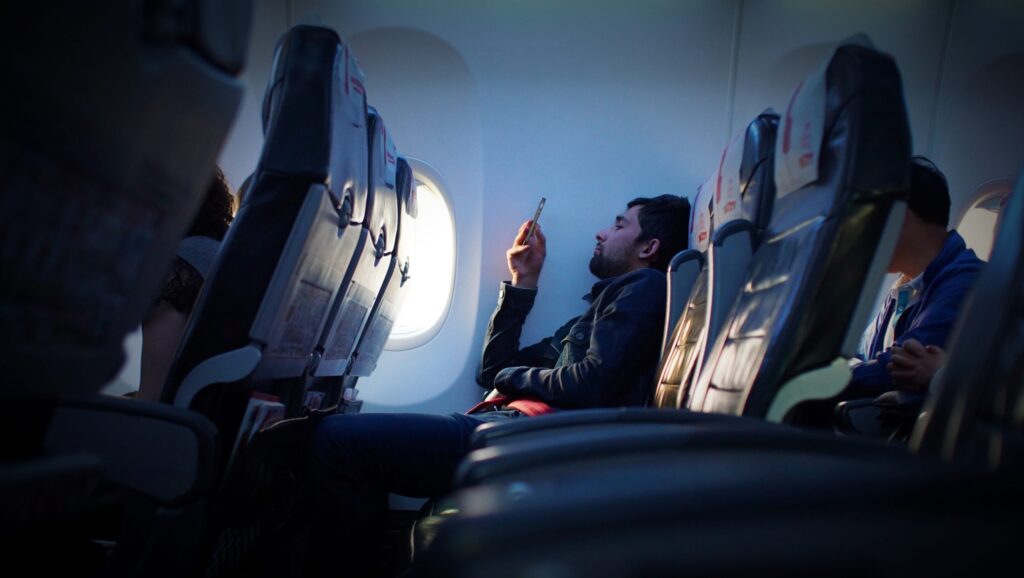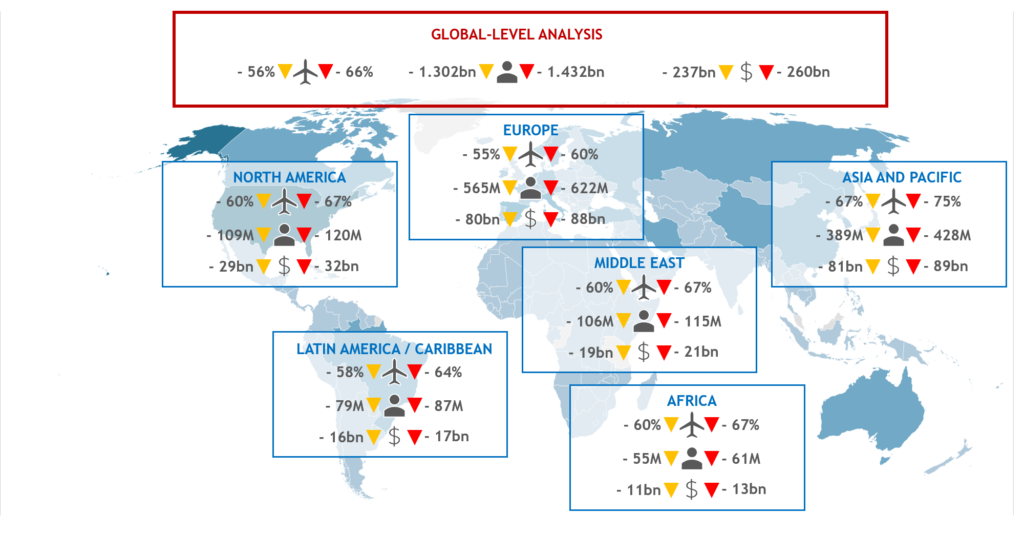

Economic Impact of COVID-19 on Civil Aviation
While the COVID-19 pandemic is first and foremost a health crisis, it has also led to major economic problems. Since the beginning of the outbreak, the civil aviation industry has been among the most severely hit sectors globally. Although the media has extensively covered the issue, the future remains unclear. The International Civil Aviation Organisation (ICAO) actively monitor the economic impact on the industry and regularly publishes reports and forecasts. The most recent ICAO report identifies two potential scenarios:
The V-Shaped scenario follows the normal shape of recession where a brief period of contraction is followed by a quick and smooth recovery. This is the most optimistic scenario, indicated with an orange triangle . This would mean reduced numbers of seats offered by airlines (from 38% to 55%), reduced numbers of passengers (861 to 1 292 million), and a potential loss of gross operating revenues for airlines (approximately USD 151 to 228 billion).
The U-Shaped scenario indicates prolonged contraction and slow recovery with a possibility of no return to a solid trend of growth. This is the most pessimistic scenario, indicated with a red triangle . This would mean even more reduced numbers of seats offered by airlines (from 48% to 71%), reduced numbers of passengers (1 108 to 1 524 million), and a higher potential loss of gross operating revenues for airlines (approximately USD 194 to 269 billion).
We do not know what will happen yet – however, this will depend on the duration and magnitude of the outbreak and containment measures, the degree of consumer confidence in air travel, and several economic conditions.


Photo: Global level analysis provided by ICAO
COVID-19 and Connectivity in Civil Aviation
Decreased confidence in flying after COVID-19 means the civil aviation industry will need to establish renewed customer support. Travel will need to take place with social distancing rules and airlines will need to maintain a higher level of cleanliness. While the industry will struggle, there is hope. Connectivity has the potential to play a central role in the rise of a new civil aviation industry post-COVID-19.
Connectivity and Health
In the wake of the COVID-19 pandemic, governments and passengers will demand new measures to ensure health and safety during all stages of air travel. This will be guaranteed at several levels, from pre-boarding checks, such as systematic temperature inspections using IoT devices, to IoT bracelets that detect vital signs, as well as being able to access digital health certificates on our phones. Some of these are already being implemented. For example, AI firms have deployed fever detection systems in Beijing to fight the outbreak.
Smart boarding is another connected solution. Passengers board the plane after they have been notified on their phone when their seats are boarding. Delta Air Lines, EasyJet and Gatwick Airport are already implementing similar measure to reduce queues and boarding times where crowds tend to gather.
Connected devices will also become important inside planes and cabin IoT data will likely be used to promote passenger wellness. For example, Airbus is willing to introduce lavatory queue information that could be presented to passengers over the on-board IFE system, allowing them to better time their visits to optimise social distancing on board. Panasonic Avionics is also considering implementing sensors on board to inform the crew about passenger activity.
Data Privacy
Before the pandemic, connected airports and planes would have faced scepticism over the risks of providing health information and advice to passengers. However, in the post-pandemic world, such an approach might be attractive for passengers and comforting for governments.
In the UK for example, the government recently introduced a 14-day quarantine obligation for those arriving in the country. The implementation of connected devices could prevent the quarantine obligation falling on all travellers, allowing those who are in perfect health to move about more freely. Introducing more connectivity solutions into the aviation industry may allow the sector to survive and support the economy as the world and business opens up, while remaining safe.
Although data will be valuable to the aviation industry, data privacy is still and will be a sensitive topic. It is therefore important to closely monitor new developments so as to ensure compliance and avoid expensive fines.
Inflight Experience
Along with ensuring a safe and healthy experience, the aviation industry will have to stimulate demand and create new incentives for travellers. One way of doing so is enhancing the inflight experience. As we become ever more accustomed to being connected (through streaming, surfing the web, working, studying and shopping online), connectivity providers, airlines and airports can leverage this trend to integrate more connectivity into their services. This will make travel more attractive, and in turn, boost the civil aviation industry. Connectivity providers are advised to monitor the rise of the online aviation industry as they begin to play an even more important role in the connectivity value chain.
Operational Efficiency
Connected aircraft will create a new and personalised experience for passengers and play a central role in boosting customer confidence. Additionally, connectivity provides opportunities for improving airlines’ additional revenues and operational efficiency. This will benefit customers, as well as suppliers, airlines, telecommunication providers, and the entire value chain. Additional revenue may come from personalised retail and advertisements, as well as new services enabled by IoT. Airlines can also improve their operational efficiency through predictive maintenance, more efficient on-board services, and creating new apps to support further smart airline goals. With predictive maintenance for example, IoT devices can inform the crew when something is broken in the cabin or is likely to break soon, such as a seat or toilet. This allows maintenance staff to be more efficient with their time and resources. IoT can also help minimise waste and make cabin services more efficient. Tools can help control temperature around individual seats, cabin humidity and smells can be minimised, and the needs of passengers can be anticipated better.